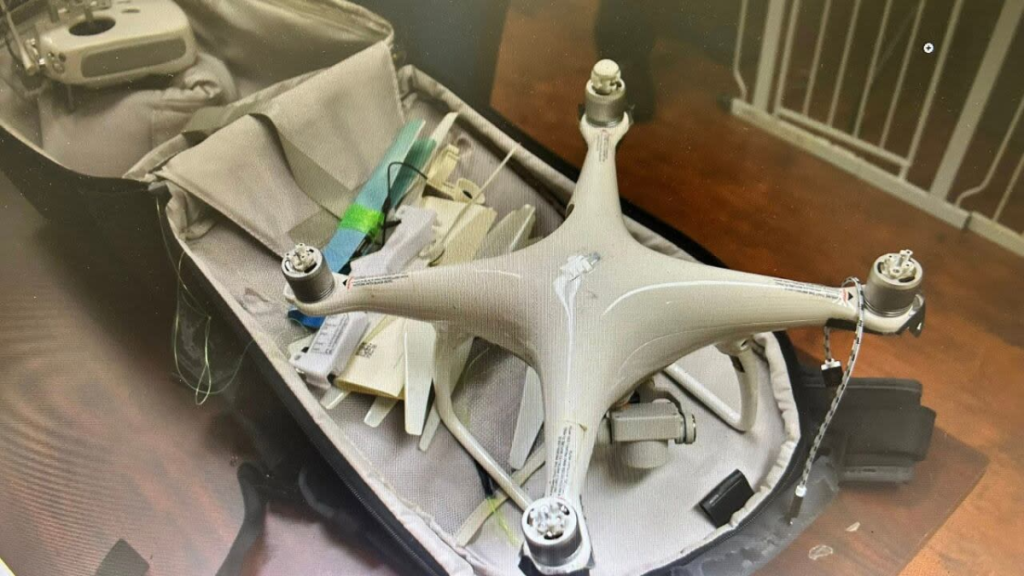MICHIGAN CITY, Ind. — Law enforcement officials have arrested two individuals accused of attempting to smuggle drugs into the Indiana State Prison in Michigan City using a drone. The incident, which occurred in late April 2025, highlights ongoing challenges correctional facilities face with contraband being delivered via unmanned aerial vehicles (UAVs), commonly known as drones.
The Incident
On the evening of April 28, 2025, correctional officers at the Indiana State Prison spotted a drone flying near the facility’s perimeter. The drone was observed dropping a package over the prison grounds. Responding quickly, prison security coordinated with local law enforcement to investigate and apprehend those responsible.
According to the Indiana Department of Correction (IDOC), officers arrested two suspects within a mile of the prison. Both individuals, identified as 29-year-old Marcus Daniels and 32-year-old Olivia Perez, face multiple charges including conspiracy to deliver controlled substances to a penal facility and possession with intent to deliver.
Contraband and Charges
Officials recovered the drone as well as a package containing suspected narcotics. Preliminary field tests indicated the package contained methamphetamine, heroin, and synthetic cannabinoids—drugs that are commonly smuggled into prisons and contribute to serious health and safety issues inside.
The charges stem from Indiana Code 35-48-4-6, which criminalizes delivering or possessing controlled substances within correctional facilities. If convicted, Daniels and Perez could face up to 20 years in prison for conspiracy alone, with additional penalties for possession and intent to distribute.
Rise of Drone Smuggling
Drone-related smuggling has increasingly become a major problem for prisons nationwide. These devices allow individuals outside prison walls to bypass traditional security measures and deliver contraband such as drugs, weapons, cell phones, and other prohibited items directly into restricted areas.
In the past five years, Indiana prisons have reported a significant rise in drone interdiction incidents. The IDOC has implemented new countermeasures including drone detection radar systems, increased aerial patrols, and enhanced perimeter security to mitigate this emerging threat.

Security Measures and Responses
IDOC spokesperson Linda Matthews explained, “While drones are a modern challenge, our staff remain vigilant in protecting the safety and security of our institutions. We continue to upgrade our detection technology and work closely with law enforcement to prevent contraband deliveries.”
Matthews also noted that the department collaborates with the Federal Aviation Administration (FAA) and local police to monitor and investigate unauthorized drone activity near correctional facilities. These partnerships are vital in tracking down individuals using drones for illicit purposes.
Legal Perspectives
Experts say prosecuting drone-related crimes is complicated by the evolving nature of drone technology and related laws. Indiana recently passed legislation allowing correctional facilities to use technology to detect and disable unauthorized drones.
This law is intended to give prisons legal authority to act quickly against drone threats without violating FAA regulations.
Professor Emily Harding, a criminal law expert at Indiana University, said, “The law is adapting to keep pace with technological advances. Using drones for drug smuggling not only endangers prison safety but also undermines the criminal justice system. Strong legal tools are essential to deter and punish these crimes.”
Community Impact
Drone smuggling into prisons has severe implications beyond the facility walls. The presence of drugs in prison increases violence, addiction, and corruption among inmates and staff. It also strains resources by requiring additional security measures and rehabilitation efforts.
Families of inmates and victims’ advocacy groups have expressed concern over these attempts, emphasizing the need for harsher penalties and improved detection to protect both prisoners and correctional employees.
Broader National Context
The Michigan City incident reflects a nationwide problem. According to the Bureau of Justice Statistics, approximately 50% of prisons across the U.S. have reported at least one drone smuggling attempt in the past two years.
Facilities are increasingly investing in counter-drone technologies ranging from radar detection to signal jamming devices.
The U.S. Department of Justice has also issued guidance to help state and local correctional agencies develop policies addressing drone threats. These efforts focus on balancing security with respecting citizens’ privacy and FAA regulations governing airspace.
Next Steps
Daniels and Perez remain in custody awaiting trial. The IDOC has launched an internal review of the incident to identify security gaps and strengthen protocols. Authorities encourage community members to report suspicious drone activity near correctional facilities to local law enforcement.
Indiana prison officials plan to hold public forums in the coming months to educate citizens about the dangers of drone smuggling and how the public can assist in prevention efforts.
Conclusion
The arrest of two individuals in connection with a drone drug smuggling attempt at Michigan City’s state prison underscores a growing challenge faced by correctional institutions.
As drone technology evolves, so too must the legal and security responses to keep contraband out of prisons, ensuring the safety of inmates, staff, and the surrounding community.
For More Information: Indiana Department of Correction
Disclaimer – Our team has carefully fact-checked this article to make sure it’s accurate and free from any misinformation. We’re dedicated to keeping our content honest and reliable for our readers.
